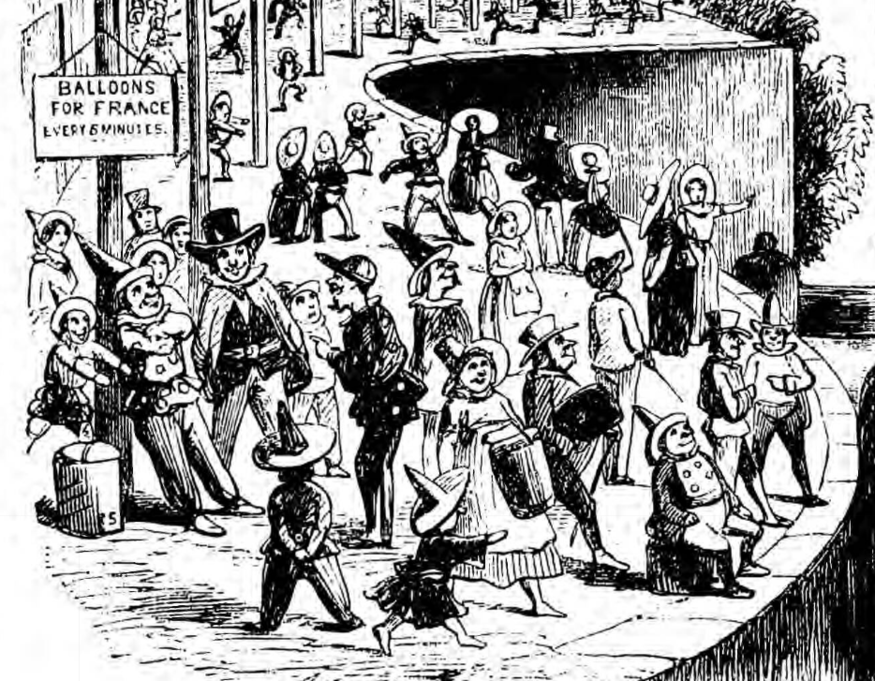
“Take care, balloon coming in,” yells the bell man. The crowd waits eagerly on the raised platform of Vauxhall New Town. An aerial machine is returning from India.
This is a Victorian vision of the future. An artist of 1856 imagines an international airport on the banks of the Thames in 1956. The prediction came some 60 years before London's first true passenger airport at Croydon.
The imagined airship is an ungainly beast. A cabin of four decks is suspended from a sausage-shaped balloon. Great air rudders poke from its sides. Two huge canopies, like horizontal umbrellas, are coupled to an engine in full reverse. Crewmen drop grappling hooks to those on the ground, while passengers admire their destination from a cumbersome poop deck.

A mock advert from the magazine sets out the timetable:
— From Bombay Direct — The original Nassau Balloon leaves Vauxhall New Town (the once royal property) Mondays, Wednesdays, and Fridays, returning every Thursday, Saturday, and Tuesday.
Here we find clues as to why our correspondent chose Vauxhall for his international airport. The author is building on recent events from his own time, and projecting into the future.
A record-breaking flight from Vauxhall
In 1836, the famous aeronaut Charles Green ascended from the area with two others in the Royal Vauxhall, a famous balloon that used coal gas as the lifting force. Green was a veteran of around 200 flights, but this was to be his crowning achievement. The Royal Vauxhall flew some 480 miles to the Duchy of Nassau in Germany, setting a distance record not broken until the 20th century.
Green went on to make hundreds of further flights before embarking on a final farewell ascent from Vauxhall in 1852. Our futurist correspondent, writing four years later, builds on Green’s achievements, imagining a world where epic balloon flights would be commonplace.
Green himself often stated his ambition to cross the Atlantic by balloon, describing the ocean as a mere canal. The illustration suggests such flights to America every day at 9am, thrice weekly trips to Bombay, and balloons to France every five minutes. The mode of transport might differ, but this is not so far from the pace of air travel today from a busy hub airport.
Half-an-Albert to perch on the wings
The crowd appears entranced by the lumbering airship coming in from the far reaches of the Empire. Many have child-like grins on their faces, suggesting that the novelty of passenger air travel still carries some magic. Note, too, their remarkable collection of hats, as though the people of the far-off 1950s might dress like witches and gnomes. At the centre of the crowd, one man wears a Tudor-style doublet and what appears to be a baseball cap. The scene, with its rag-tag ensemble of ludicrous couture, is more a herald of Camden Market than 1950s Vauxhall.

After explaining the fare system (an Albert to sit in the main car, a Victoria-and-a-half for the ‘birdcage’ section, and half-an-Albert to perch on the wings), the accompanying article treats us to some health and safety information from the balloon’s Director.
“For the safety of his passengers, he hereby warns all persons against flying kites, letting off rockets, or holding umbrellas, at more than one mile from the earth, as it is his intention to drop down upon all offenders. No smoking allowed in the Birdcage.”
Whatever inaccuracies this vision contains, at least it predicted the smoking ban on public transport.
The report concludes by speculating that the feats of Green and his ilk will seem insignificant to the eyes of people in the 1950s. Perhaps, but Green’s ambition of crossing the Atlantic in a hot-air balloon was not achieved by others until 1978, almost 30 years later than our Victorian futurist predicted daily flights from Vauxhall. It’s interesting to note that while aviation advanced in ways largely unthinkable to the writer of the 1850s — with vast passenger aircraft and jet engines — the technologies and capabilities of balloonists have not progressed at anything like the pace envisaged.
“Thus in 1950 men are literally to fly through the air. There is no impediment to foreshadow — no conditions to state. The hurricane, the gale, the sunken rock has no terrors — for men have risen superior to such obstacles. If we may suppose any love of antiquity to be left in such a people, and that they may cherish any love for the manners and literature of the past, how ludicrous in their eyes will seem the provision sometimes made in the bills and advertisements of their ancestors a century before — "The Queen of the Ocean will sail (weather permitting, &c.).”
If you’ve ever booked onto a balloon flight only to be thwarted by the merest puff of wind, you’ll appreciate how necessary that ‘weather permitting’ remains for this mode of transport.
Images taken from the Alnwick Mercury, 1 February 1856. (c) The British Library Board. All rights reserved. Found in the British Newspaper Archive.




